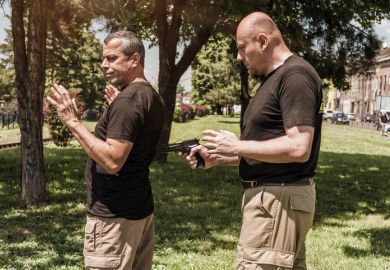Source: Getty
Great strides: Medellín’s transformation from murder capital to bustling city has helped to encourage international study
In downtown Medellín – once a global symbol of the drug-related violence in the cocaine trade – stands the bright yellow San Ignacio building. Built in 1803, this first campus of the University of Antioquia survived Colombia’s colonial rule by Spain, which ended in 1810.
And 200 years later, it is witnessing Medellín’s recovery from the drug cartels that ruled by terror and, for a time, made the city the most dangerous in the world.
Investment and improvements in security in the past 20 years have allowed it to shed its reputation as a murder capital. In a recent study of the world’s most dangerous cities, it was ranked only 49th, and is likely fall out of the top 50 this year.
The ebbing of the violence and the restoration of normality have improved conditions in Medellín, and one of the beneficiaries has been the country’s oldest public university.
Those in Antioquia’s Office of International Affairs say that the city’s transformation has helped efforts to internationalise the institution. With an investment of more than £460 million from sources including local and national government, Antioquia now has international agreements with 46 countries.
Last year, the number of foreign visiting professors reached 860, almost tripling in just two years. And for the first time, the proportion of Antioquia students on exchanges abroad reached 1 per cent, the average across Latin America.
“Medellín was [once] the most dangerous city in the world,” said Carolina García, from the university’s Office of International Affairs. “Now we have to devise summer programmes because every one of our partners is asking for summer programmes in Colombia.”
As well as international agreements, the university has four strategic alliances with overseas institutions. Recently, it added a link-up with the UK through its “From Country to Country” programme, capping off a series of high-profile political visits including president Juan Manuel Santos’ trip to the UK in 2011.
“We sign agreements only when they’re going to be productive,” Ms García explained. “We have strategic alliances with four universities in which big institutions are really committed to the relationship.”
The university’s new rector, Mauricio Alviar Ramírez, has made internationalisation a priority. He intends to increase the number of Antioquia undergraduates and postgraduates studying abroad and to raise the number of foreign students in Medellín.
“We have to be realistic, but we can say that the number of international students in the university has grown,” Ms García said.
With 39,000 students at 11 campuses across the department of Antioquia, the university has the biggest concentration of students in the country. In the past two decades, it has expanded beyond the city to include satellite sites in all the department’s subregions, including the troubled area of Urabá, where guerrillas of the Revolutionary Armed Forces of Colombia (Farc) have clashed with the government.
“Twenty years ago, there were no universities in rural areas. Now we have 11 campuses in the region,” said Laura García, coordinator in the Office of International Affairs.
There has also been an effort to foster innovation within the university since the Urban Land Institute named Medellín the Innovative City of the Year in 2013 for its impressive turnaround.
Antioquia submitted two proposals for vocational courses to RutaN, a higher education firm that runs Innovacampus, a programme to encourage universities to offer more professional courses and skills to prepare graduates for work.
A moving challenge
Of the goals the university has set itself, that of increasing international mobility may be the most challenging. More than half of Antioquia’s students, 55 per cent, come from the least well-off social classes and do not pay tuition fees.
“Our students don’t have the economic resources and economic capacity [to go abroad], so we are trying to get a lot of resources not only via our office but with other departments of the university to create a fund to help our students,” Ms Carolina García said.
Another aim for 2015 is to increase international mobility within the subregional campuses.
“Thanks to the pilot internationalisation strategy that we started implementing in the regions in 2013, we had 11 students on academic exchange activities and participating in lectures [abroad] last year,” said Carolina Laverde, Office of International Affairs director.
The university already has some impressive results to attest to the success of its approach.
Every year, six to eight Antioquia students study at Harvard University, and four from Harvard take up internships in Medellín. Antioquia also has links with the University of California, Berkeley.
Edisson Castaño, a mechanical engineering student from Antioquia who took up a research internship at Berkeley, said: “The most satisfying thing for me was to have been accepted at Berkeley, to have my colleagues [there] believe in me and my ideas, and to be able to help them solve problems from what I learned in Colombia.”
Register to continue
Why register?
- Registration is free and only takes a moment
- Once registered, you can read 3 articles a month
- Sign up for our newsletter
Subscribe
Or subscribe for unlimited access to:
- Unlimited access to news, views, insights & reviews
- Digital editions
- Digital access to THE’s university and college rankings analysis
Already registered or a current subscriber? Login





